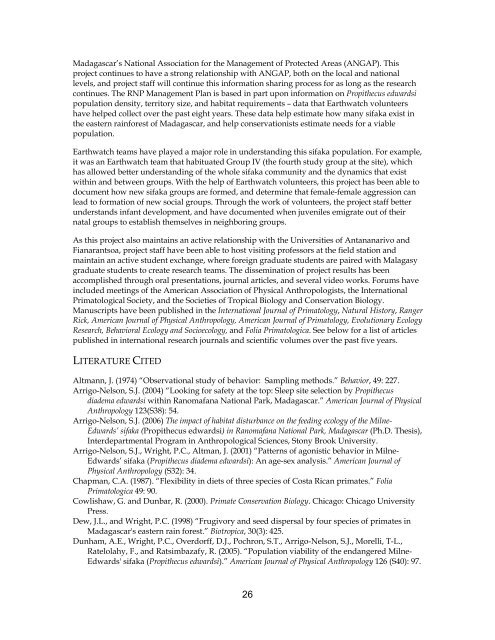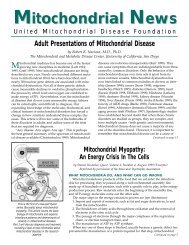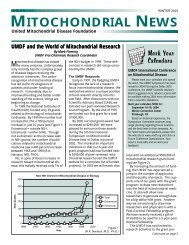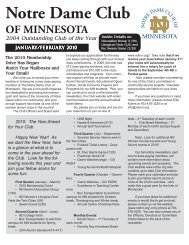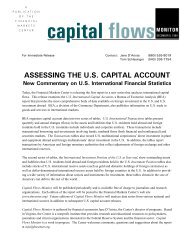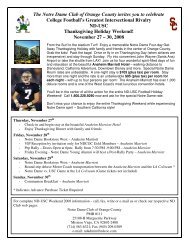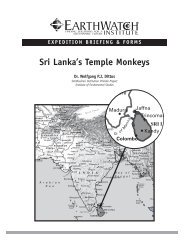Madagascar's Lemurs
Madagascar's Lemurs
Madagascar's Lemurs
You also want an ePaper? Increase the reach of your titles
YUMPU automatically turns print PDFs into web optimized ePapers that Google loves.
Madagascar’s National Association for the Management of Protected Areas (ANGAP). This<br />
project continues to have a strong relationship with ANGAP, both on the local and national<br />
levels, and project staff will continue this information sharing process for as long as the research<br />
continues. The RNP Management Plan is based in part upon information on Propithecus edwardsi<br />
population density, territory size, and habitat requirements – data that Earthwatch volunteers<br />
have helped collect over the past eight years. These data help estimate how many sifaka exist in<br />
the eastern rainforest of Madagascar, and help conservationists estimate needs for a viable<br />
population.<br />
Earthwatch teams have played a major role in understanding this sifaka population. For example,<br />
it was an Earthwatch team that habituated Group IV (the fourth study group at the site), which<br />
has allowed better understanding of the whole sifaka community and the dynamics that exist<br />
within and between groups. With the help of Earthwatch volunteers, this project has been able to<br />
document how new sifaka groups are formed, and determine that female-female aggression can<br />
lead to formation of new social groups. Through the work of volunteers, the project staff better<br />
understands infant development, and have documented when juveniles emigrate out of their<br />
natal groups to establish themselves in neighboring groups.<br />
As this project also maintains an active relationship with the Universities of Antananarivo and<br />
Fianarantsoa, project staff have been able to host visiting professors at the field station and<br />
maintain an active student exchange, where foreign graduate students are paired with Malagasy<br />
graduate students to create research teams. The dissemination of project results has been<br />
accomplished through oral presentations, journal articles, and several video works. Forums have<br />
included meetings of the American Association of Physical Anthropologists, the International<br />
Primatological Society, and the Societies of Tropical Biology and Conservation Biology.<br />
Manuscripts have been published in the International Journal of Primatology, Natural History, Ranger<br />
Rick, American Journal of Physical Anthropology, American Journal of Primatology, Evolutionary Ecology<br />
Research, Behavioral Ecology and Socioecology, and Folia Primatologica. See below for a list of articles<br />
published in international research journals and scientific volumes over the past five years.<br />
LITERATURE CITED<br />
Altmann, J. (1974) “Observational study of behavior: Sampling methods.” Behavior, 49: 227.<br />
Arrigo-Nelson, S.J. (2004) “Looking for safety at the top: Sleep site selection by Propithecus<br />
diadema edwardsi within Ranomafana National Park, Madagascar.” American Journal of Physical<br />
Anthropology 123(S38): 54.<br />
Arrigo-Nelson, S.J. (2006) The impact of habitat disturbance on the feeding ecology of the Milne-<br />
Edwards’ sifaka (Propithecus edwardsi) in Ranomafana National Park, Madagascar (Ph.D. Thesis),<br />
Interdepartmental Program in Anthropological Sciences, Stony Brook University.<br />
Arrigo-Nelson, S.J., Wright, P.C., Altman, J. (2001) “Patterns of agonistic behavior in Milne-<br />
Edwards’ sifaka (Propithecus diadema edwardsi): An age-sex analysis.” American Journal of<br />
Physical Anthropology (S32): 34.<br />
Chapman, C.A. (1987). “Flexibility in diets of three species of Costa Rican primates.” Folia<br />
Primatologica 49: 90.<br />
Cowlishaw, G. and Dunbar, R. (2000). Primate Conservation Biology. Chicago: Chicago University<br />
Press.<br />
Dew, J.L., and Wright, P.C. (1998) “Frugivory and seed dispersal by four species of primates in<br />
<strong>Madagascar's</strong> eastern rain forest.” Biotropica, 30(3): 425.<br />
Dunham, A.E., Wright, P.C., Overdorff, D.J., Pochron, S.T., Arrigo-Nelson, S.J., Morelli, T-L.,<br />
Ratelolahy, F., and Ratsimbazafy, R. (2005). “Population viability of the endangered Milne-<br />
Edwards' sifaka (Propithecus edwardsi).” American Journal of Physical Anthropology 126 (S40): 97.<br />
26


